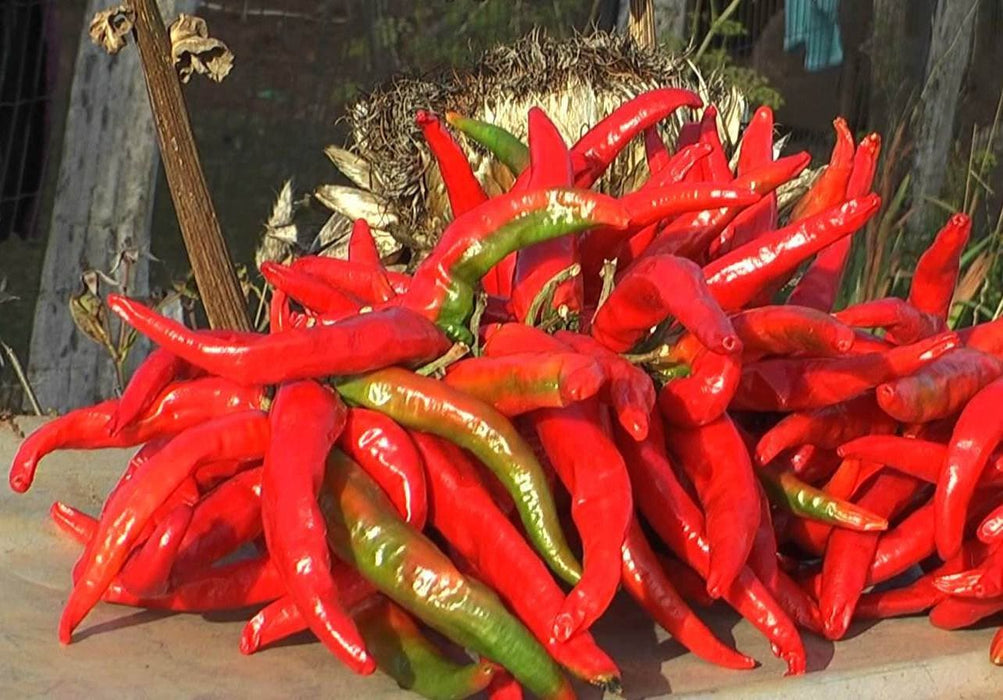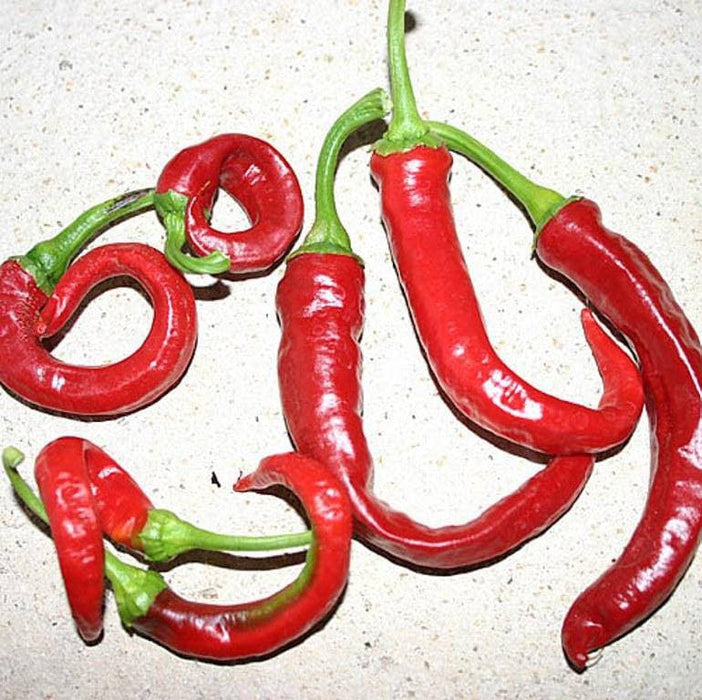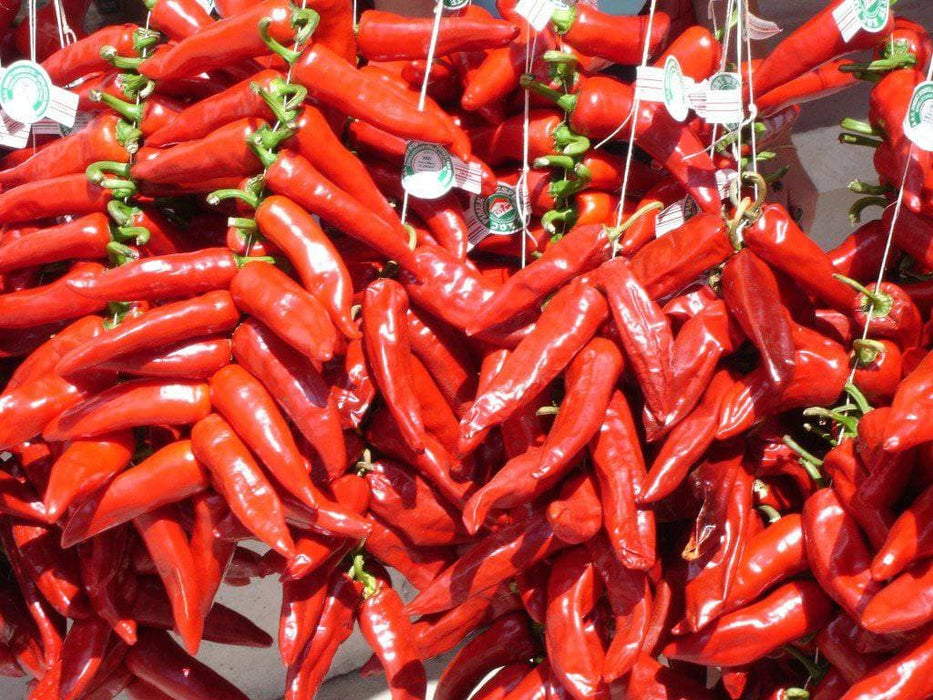
Aji Cacho de Cabra, Medium hot PEPPER SEEDS (Capsicum baccatum)
Most orders are processed by the next day
Select your desired size and/or color from the available options.
A unique pepper: fruity, smoky, and plenty hot. Use to Make "Merkén" a Popular Chilean Spice Blend
hot; Andean Aji; 3.5 to 4 inches long by 0.375 to 0.5 inches wide; medium thin flesh; matures from green to red; upright pods become pendant; green leaves; 30 to 36 inches tall; Late Season (80-90 days); from Chile; used by the Mapuche Indians to make Merken (Merqueen) spice blend; C.baccatum.
Cacho de Cabra (“aji” is the term generally used to describe chilies from South American countries) is a smoked chile grown in Chile. It’s one of the most common ingredients in native Mapuche cooking, and is experiencing newfound popularity in contemporary Chilean cuisine. It’s also the pepper used in the famous Merken spice blend, which usually also contains toasted coriander and salt.
It can be used, ground, in a plethora of dishes: grilled meat, poultry marinades, chili con carne, soups and stir fried dishes. It can also be rehydrated and used for aromatic chili pastes, braising, sauces, or dips of all types.
Our cacho de cabra comes from the Maule region in the center of Chile. The harvest runs from December to March, when temperatures stay above 30° C. These high temperatures give this chile pepper its body, heat, and exceptional flavor. These peppers are harvested by hand, then allowed to sun dry naturally. After being exposed to the sun, the chilies are rested in a mud smoker, usually with local eucalyptus wood, for around a week.
Soak the seeds in lukewarm water for a day before sowing and so on 5 mm deep in seed compost.
Keep the soil moist but not wet.
Thrives in sunny windows, conservatories, greenhouses, outdoors in sunny and sheltered position during the summer.
When grown during the winter months usually required some form of plant lighting. Help with pollination by shaking the plant or with a small brush. More Yearling - trimmed in the fall - overwinter indoors in bright mode.
1
Mix equal parts potting soil, compost, perlite and sphagnum moss. Fill a 12-inch pot 3/4 full with the mixture. The pot should have adequate drainage. Start seeds two months before the planting season. Sow seeds on the surface and cover with a sprinkling of soil. Cover the seeds with plastic and keep them in a south-facing window. Mist the soil to keep it moist.
2
Plant seedlings in time to put them out after the last frost. When planting seedlings, place the plant in the center of the pot and cover the roots with soil. Water thoroughly and add more soil if necessary.
3
Place the potted pepper in full sun. Set a small tomato cage -- 2 to 3 feet high -- over the pot to support the plant as it grows. Water the pepper daily if necessary to keep the soil moist.
4
Fertilize every two weeks with half-strength liquid tomato fertilizer beginning when blooms appear.
5
Harvest the peppers as soon as they ripen to keep the plant producing. Once the pepper turns dark orange or red it is ripe. Cut the pepper from the plant just above the fruit. Peppers left on the plant too long will develop a hotter flavor.
6
All pepper varieties are Heirloom and/or OP(Open Pollinated.) and Organically Grown.
Growing Peppers:
Peppers, like tomatoes, grow in well-drained fertile soil
Almost all peppers have the same requirements for successful growth. Plant them in good, well-drained, fertile soil – and make sure they get lots of sunlight and a good inch of water per week. In many ways, they mimic the same requirements needed for growing great tomatoes.
At Planting Time:
We plant all of our peppers with a good shovel full of compost in the planting hole, and then give them a good dose of compost tea every few weeks for the first 6 weeks of growth. We also mulch around each of our pepper plants with a good 1 to 2″ thick layer of compost.
All pepper varieties are Heirloom and/or OP(Open Pollinated.) and Organically Grown
Peppers often like to take their sweet time germinating. They can be up in a week, and some will take almost a month. Even with paper towel germination testing, they can take long. I am not sure why, but it is a normal occurrence. So plan and make sure you start them early enough! Also, remember they like heat to germinate so make sure you have a heating mat or something to keep the soil warm. Placing them up on top of the fridge often works too since it is normally warmer up there.
Peppers do very well grown in pots.
Select your desired size and color from the available option
LET OUR CUSTOMER SPEAK FOR US

![[Seeds] - Caribbeangardenseed](http://caribbeangardenseed.com/cdn/shop/files/gift-card-gift-card-1_1024x1024_dfa857db-9150-4315-a362-7f0bb3fb9c47_60x28.png?v=1703978838)

